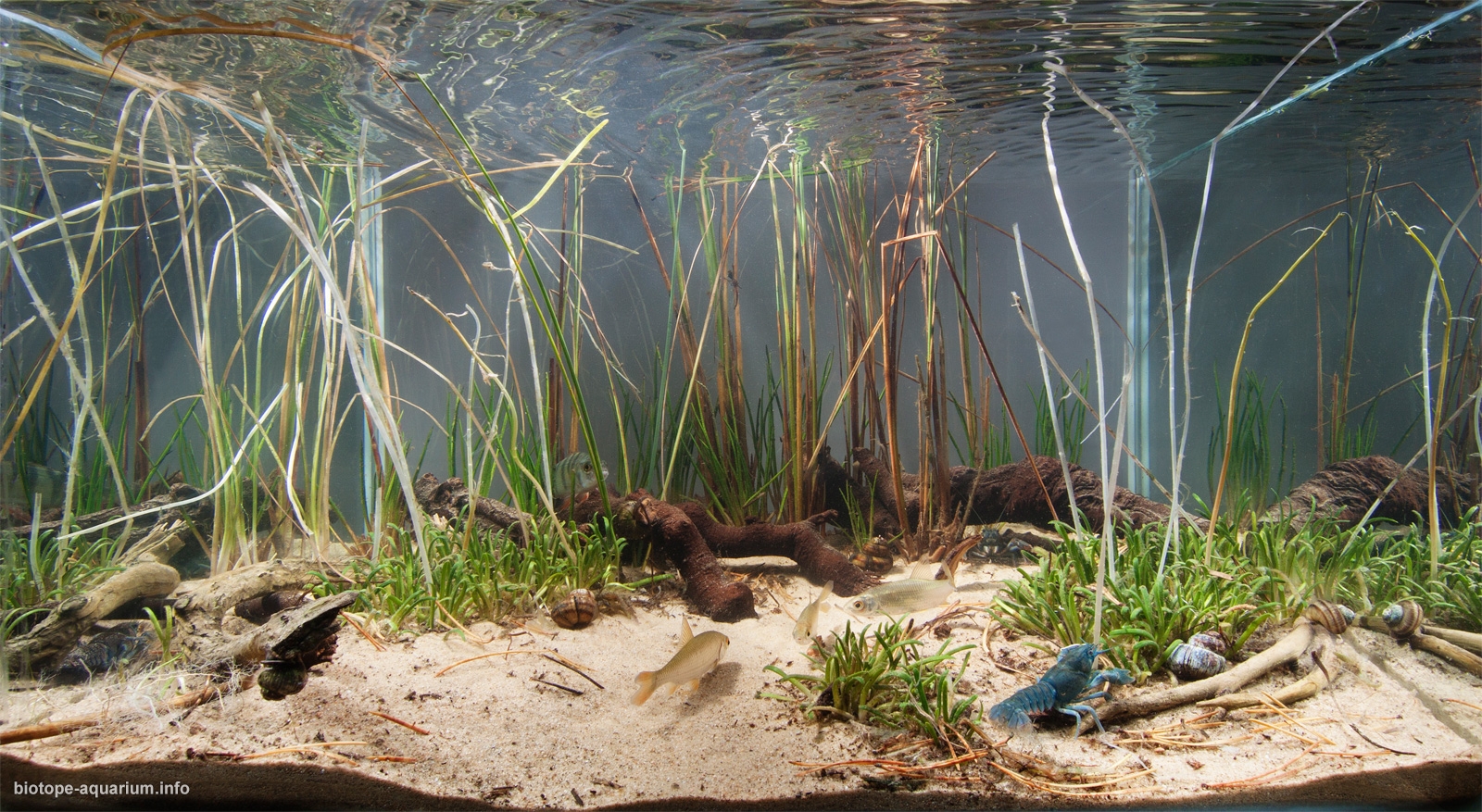Shallow water of the Tobolki lake, Pskov region, Russia
13th place in Biotope Aquarium Design Contest 2017
![]() Russia. Natalia Zakharova
Russia. Natalia Zakharova

Volume: 105 L
Dimensions: 70x50x30 cm
List of fishes: Astacus astacus, Viviparus contectus, Rutilus rutilus, Perca fluviatilis
List of plants: Lobelia dortmanna, Carex crinita
Description of decorations: The substrate is UDeco River Amber, fraction 0.1-0.6 mm. Mixed with sand from a natural reservoir. The sands are very similar in color and fraction. Driftwoods of leaf tres and supposedly pine. Well soaked in a natural pond.
Description of equipment: JBL CRISTAL PROFI E 701 greenline external filter, Aqualighter LED. The aquarium is installed in the unheated part of the residential building. The temperature in it varies depending on the time of year. From 5°С (in winter) to 25°С (in the summer). Therefore, additional equipment for cooling or heating water is not required. Temperature fluctuations are similar to natural ones.
Water parameters: Temperature 18°C, pH 7, KH 1, GH 3, NH3 / NH4 0, NO2 0, NO3 10, PO4 is measurable. TDS 60
Description of the area surrounding the biotope: In the Pskov region of the Gdov district, there is a small pond with the ridiculous name Tobolka. The lake is in a beautiful pine forest. Hilly terrain and huge sand dunes create an indescribable feeling. Small, but characteristic for this locality trees: alder, mountain ash, birch, etc. grow between perennial pines. In some places, branches of trees hang over the water, so there is always a little needy in shallow water. In more humid lowlands, around the lake, the Ledum and other marsh vegetation feel great. Of course there is a lot of heather and moss. A variety of sedges grow along the coastline, which periodically turn out to be under water. Literally a few dozen meters from Tobolki there is a larger lake, Uzhinskoe, and only a few kilometers away is the famous Peipsi Lake.
Description of the underwater landscape of the biotope: Tobolki is a small lake, about 25 ha in size. The ground is fine, probably quartz. The color from the shore seems light gray, almost white, but on closer examination the sand has a light yellow hue. In the depths of the lake there are layers of blue clay. The uniqueness of this lake is certainly in its inhabitants. There is a Astacus astacus with five varieties in color: brown-blue, blue, brown, black, blue. Fish: Cobitis taenia, Rutilus rutilus, Perca fluviatilis, Esox lucius. Mollusks (Viviparus contectus). Pike and loach were not placed in the aquarium, as in a small space, some will become food for others. The lake as if specially divided into small, but clearly marked zones, in each of which crayfish of a certain color predominate. Brown live close to the shore, under driftwood and branches lying on the bottom. Blue are at depth. Brown-blue and black colors occur at the junction of the zones. The main part of the shallow water is covered with dense thickets of Lobelia dortmanna. This low plant, with a very powerful root system, is not often found in our reservoirs. It prefers pure clear water. During flowering, the surface of the water along the shore is literally covered with a white and blue carpet. Slightly deeper Carex crinita grows, in the thickets of which juvenile fish hide. In small areas densely covered with reeds, with a marshy bottom crayfish practically is not found. In areas with bare ground, you can see various water insects and mollusks. Crayfish come here. The gently sloping banks and the lack of shelter forced some of the crayfish to go far from the shore. In this zone there are few aquatic plants, rare water lilies and individual reed stalks do not form dense thickets characteristic for these plants. The layers of blue clay here come very close to the surface, along the bottom there is a layer of very shallow blue suspension. Probably, this is why the crabs have acquired such an unusual color.
Description of the parameters of the habitat: The water in the lake is very clear and soft (pH 7, KH 2, GH 2), TDS is only 40 ppm! Shells of mollusks are in most cases severely destroyed. For me it’s amazing how the crayfish molt in water with such parameters. Apparently all the necessary minerals for the construction of the shell are in the clay. The water level varies depending on the season and the amount of precipitation. In summer the water is very clear, visibility of several meters. During the rainy season, the water level rises, more suspended matter forms, various algae appear, although in summer the plants are unusually clean, practically free of algae.
List of fishes: Astacus astacus, Viviparus contectus, Rutilus rutilus, Perca fluviatilis, Cobitis taenia, Esox lucius.
List of plants: Lobelia dortmanna, Carex crinita, Nuphar lutea, Phragmites australis.
Threats to the ecology: Not far from the Tobolki lake, there is a children’s recreation camp. Therefore, a lot of people come to rest on the lake. The unusual color of crayfish not only draws attention, but also makes them very noticeable on a light ground. Earlier, crayfish lived in many reservoirs of Russia, and now they have become rare. Part of the reason is an environmental pollution, but the main threat of extinction is still people who catch them, not observing the elementary rules. Including during the breeding season. Do not hesitate to take females with eggs and very small crayfish, where there is nothing to eat. The Tobolki lake is one of the very few places where a population of broad-shouldered crayfish still exist. I hope that the contest will help to draw people’s attention to this problem. And then there will be hope for the survival of these enchanting blue invertebrates.
Sources of information: https://vk.com/biotope_aquarium?w=wall-52983980_6817; I’ve been on this lake many times, so I watched the life at different times of the year and day.
Comments of the members of the jury of Biotope Aquarium Design Contest 2017

For me this entry is special because I personally was on this lake and I can confirm that everything is correct from the point of view of decorations and technique. It was the first time in my life I saw the indigo and blue morphs of Astacus astacus shellfish in nature.
